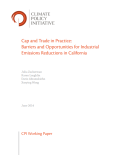
Effective water management is a crucial ingredient for green growth. It is becoming increasingly clear that astute investment in, and management of, water can help to drive green growth. To do this, governments must catalyse water-related investment and innovation that underspin sustained green growth and give rise to new economic opportunities. Drawing on recent OECD work on policies to support green growth, and on water economics and governance, this Policy Perspectives brochure lays out the opportunities to manage and invest in water as a means for green growth. This paper identifies the key policy options that governments can use to assist this transition towards greener growth.
Indonesia’s desire to drive economic growth and reduce climate risk is reflected in the sweeping policy reforms it has introduced in recent years to meet targets announced in 2009 to reduce greenhouse gas emissions. In this report, CPI identifies which public actors are investing in Indonesia, through which instruments, and what they are investing in to provide a baseline against which to measure progress and plan scale up. The landscape reveals investment patterns that allow decision makers to pinpoint where the biggest barriers and opportunities are.

California is both one of the largest economies and one of the largest emitters globally, making its climate change policies some of the most important in the world. They are also some of the most ambitious. In particular, California’s Global Warming Solutions Act of 2006 (AB32) set a series of policies and programs across all major business sectors to return California emissions to 1990 levels by 2020. A key component of this set of policies is the Cap and Trade Program, which caps greenhouse gas (GHG) emissions from key business sectors in California. With the Cap and Trade Program in its second year of full operation, CPI studies how firms make business decisions in the presence of a carbon price — whether abatement options that have been identified as technically feasible prove to be attractive in practice, or whether barriers prevent firms from pursuing otherwise cost-effective abatement options.
Concentrated solar power (CSP) is a promising technology for low-carbon power generation. Thanks to abundant solar resources in the world’s sun belt and its ability to provide flexible and reliable power supply when combined with thermal storage, CSP could play an important role in maintaining a steady power supply in future low-carbon energy systems with high penetrations of fluctuating renewable power from solar photovoltaic and wind. With findings drawn from four case studies and background paper, this policy brief offers recommendations for international finance institutions (IFIs) and developing country policymakers on how to deploy concentrated solar power (CSP) while achieving cost reductions.
Electricity systems across the U.S. and Europe face significant challenges in the transition to low-carbon energy. While the transition provides plenty of opportunities for investors, businesses, and consumers alike, the current business and regulatory models of investor owned utilities (IOUs) and independent power producers (IPPs), which have mainly developed around competitive markets for fossil fuel generation, are particularly ill-suited to take advantage of these new opportunities. This paper outlines the some major challenges each business segment will face and sets out a roadmap for addressing the challenges.
